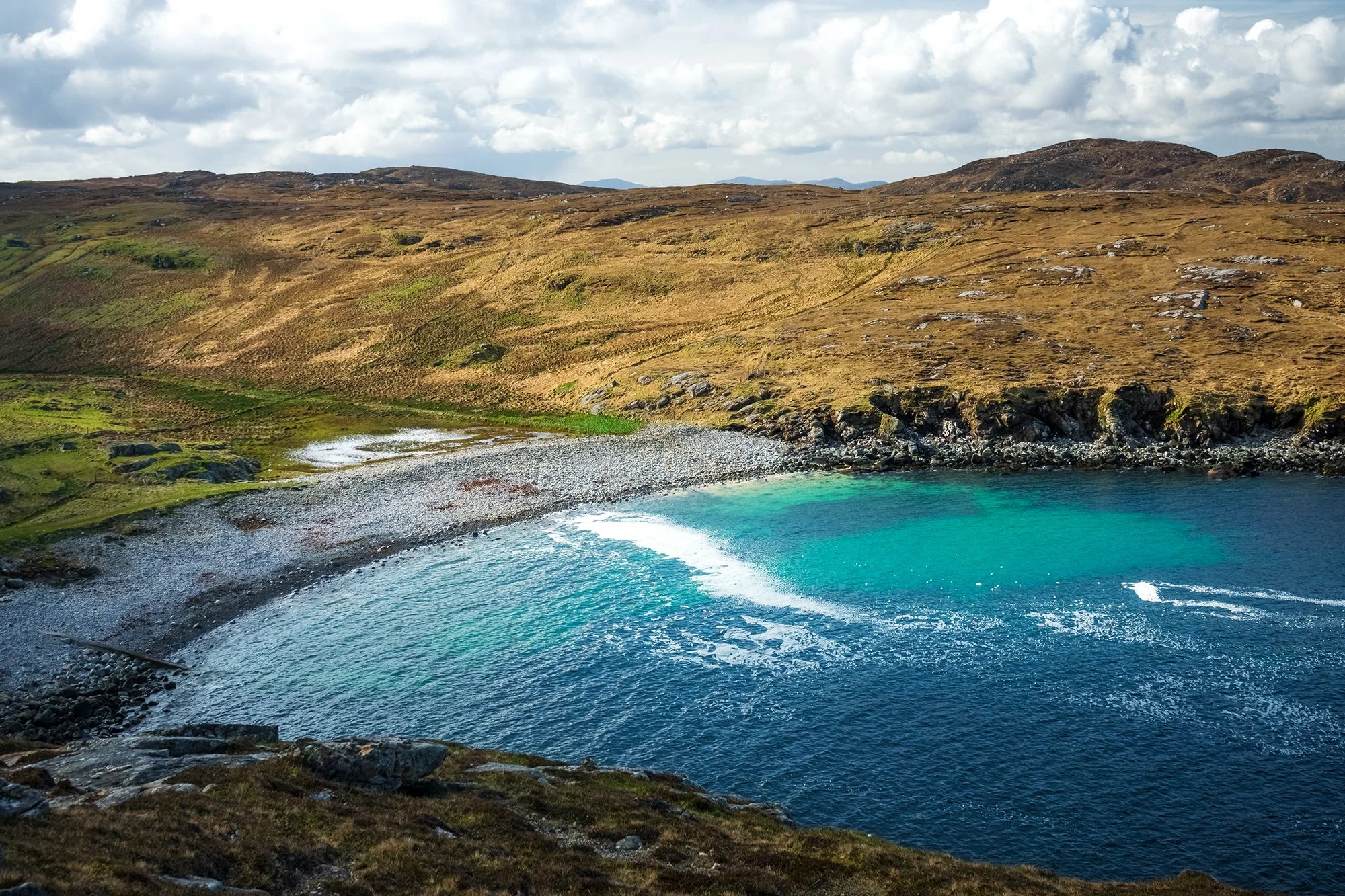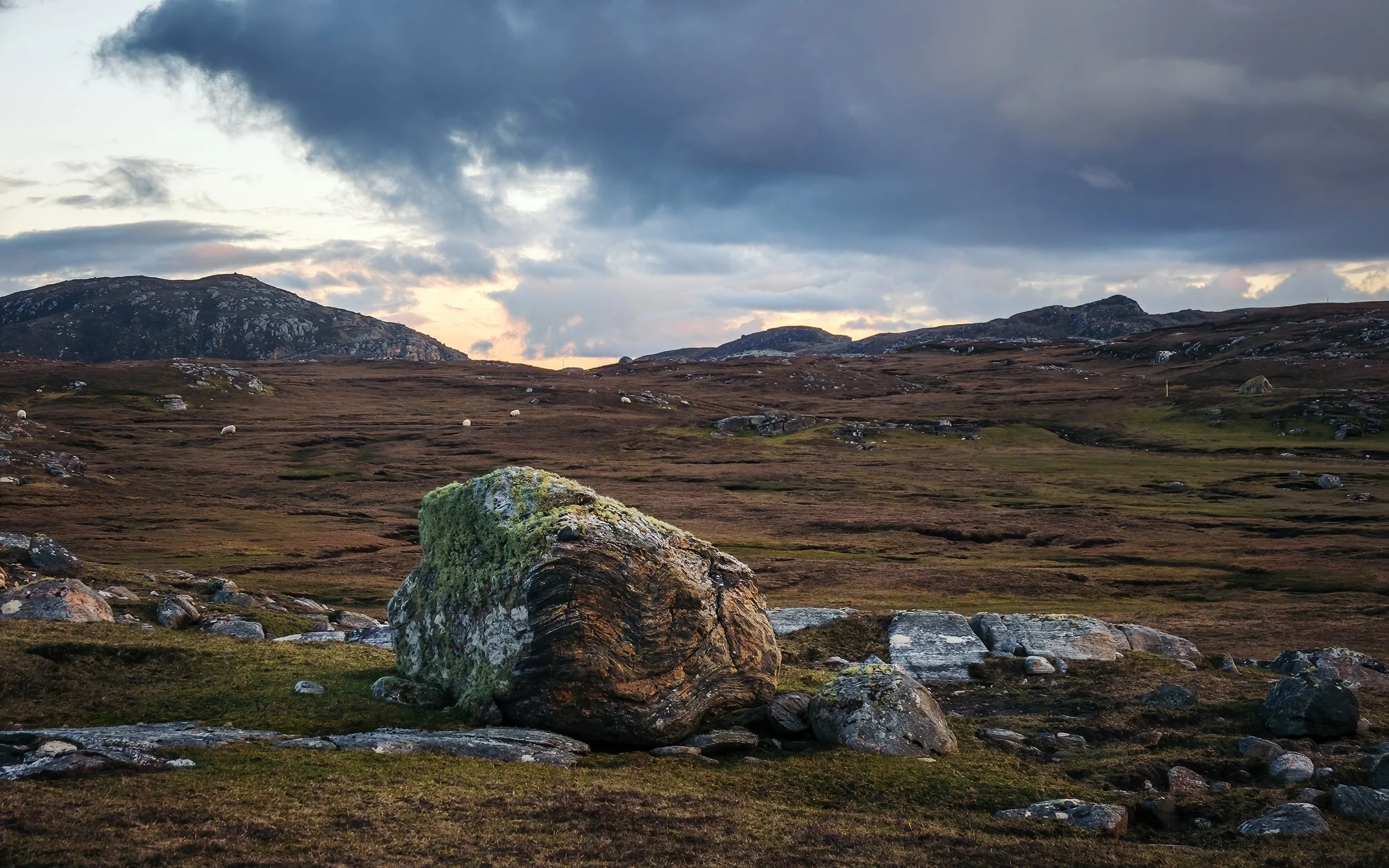“The sea’s a bit wild out there in the wind, breaking white all around those rock stacks. I can even feel a hint of spray on my face. Light, like the touch of a feather. Wind’s blown all the clouds away now. There were days out on the moor I’d have killed for a piece of blue sky like that.”
- Peter May
The Blackhouse
Another relaxed morning, another gigantic full Scottish breakfast to start the day. Today, I’ll be driving up the west coast of Lewis, mostly sightseeing rather than doing any serious exploration of photography. It feels like the trip has reached a denouement of sorts. I bid farewell to the friendly proprietors at the Doune Braes hotel and head up the road. My first stop is in Carloway to visit the ruins of an Iron Age broch (fortified tower-dwelling). Jane and I visited two brochs during our 2015 trip - one in Glenelg, and one in Skye - but this is the first one I’ve been able to climb up to the second floor using a set of restored stone steps. Before leaving, I visit the small nearby visitor center which has dioramas depicting life in the ancient times. Next, I stop in Carloway to photograph the village and its church, followed by a visit to Na Gearannan’s traditional blackhouse village. The village’s thatched huts appear much as they did in centuries past, and were lived in until the 1970s. Nowadays, several of them have modernized interiors and are mostly rented by holiday-goers seeking an idyllic escape by the oceanside. I climb up onto the sea cliffs behind the village, gaining an impressive view from above of the nearby beach and cove.
Throughout the morning, I continue making my way up the west coast, stopping at various beaches and doing small portions of Lewis’ coastal walk, a long waymarked trail that connects many of the townships and beaches that dot the island’s coastline. At Dail Mor and Dail Beag beaches, I shoot the waves crashing upon impressive basaltic cliffs. I see another photographer with full long-exposure setup (tripod and ND filter) shooting the outgoing tide as it washes away from the rocks at Dail Beag, but frankly I am too tired (and it is mid-day) to be doing any serious photography. Mostly I stroll about with my shades, windbreaker, and camera in hand, enjoying the good weather and shooting whatever I see.
In the afternoon, some brief roadside stops at points of interest in the coastal villages: the ruined Norse mill at Shawbost (its thatched roof looking quite worse for the wear after storms in the past year), a massive whale jawbone in Bragar (erected into the front gate of a roadside house), historic houses and ruins in Arnol, and a small shieling (summertime bothy used by crofting families when moving their herds between seasonal grazing grounds) in Brue. The shieling, especially, I love. It is much cozier on the inside than I expected; on the wall is posted a list of Gaelic sayings, and outside, a place map highlighting the Gaelic names for features across the landscape within a few square miles - it seems that every stream, loch, hill, crag, and rock has a name and special significance. Here in the Outer Hebrides, modernization has come quickly in recent decades. But amidst the cars, roads, and conveniences of globalized life (flights and ferries on Sundays - although most businesses still observe the Sabbath), the traditional ways still have a strong place in island life. By the roadside, I still see many crofters tending to their sheep, working the land, and cutting peat for fuel in neat banks.
After refueling the car and buying some petrol-station lunch (sandwiches and an ice cream bar), I eat in one of the ubiquitous church parking lots - for every village, no matter how closely spaced they may seem in the age of asphalt highways, has a church - usually spare, simple, and unadorned, in line with the strong Protestant culture here on Lewis. Then, it’s further up the island to the community of Galson, where I check into my little croft for the last two nights of the trip. It’s a cute little retreat, just up the road from the local beach and cemetery, and I share a wall with the sheep in the farmhouse stable. There are occasional bleats and baa’s throughout my nap in the afternoon, but my new wooly friends are surprisingly quiet at night.
For my evening outing, I retrace my route back to Shawbost, where I plan to hike out to the coast to photograph Stac a’ Phris, a massive sea arch not unlike Drangarnir in the Faroes. It’s taken me a lot of research and map study to work out how to walk out to the arch, from the road, without hitting too much bog, but I think I have a good route that lets me connect up with the Lewis coastal walk fairly quickly. After following the green-tipped waymakers for less than a mile, I see the unmistakable slanted top of the arch, and cut down to the cliff’s edge for a closer look. Making my way down carefully on the rocks (slippery with lichen and guano), I set up my tripod and play around for the next two hours with a variety of compositions and shutter speeds. Ultimately, I decide to use exposure blending to control the high dynamic range of the scene (shooting almost directly into the sun) and combine features from multiple images (fast shutter speeds for wave action, soaring birds, and skies; slow shutter speeds for rock detail and a smoother ocean surface). As the sun sinks into the marine layer, I pack up and head back across the peat, stopping to take some final images of the incoming weather, and a nearby sheep. Before dark, I make it back to the outfields of Shawbost, and the warm incandescent streetlights of the island villages are just flickering on as I return to Galson for a well-deserved rest.








































































